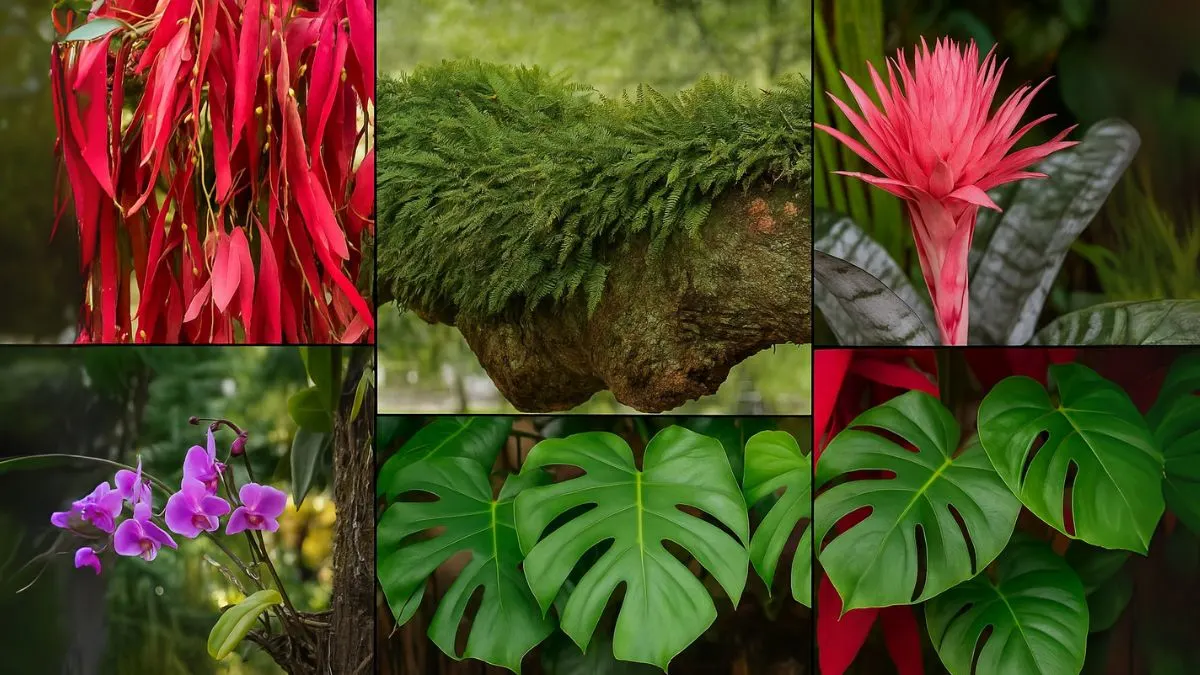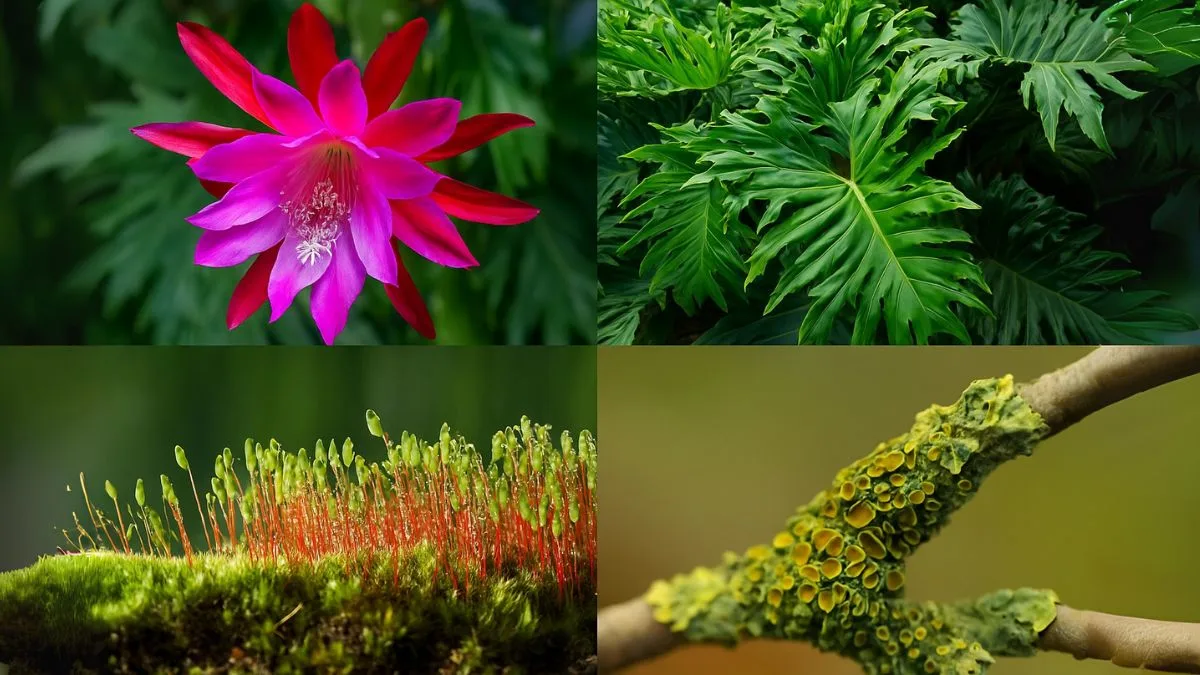When we think of houseplants, we imagine them rooted in soil. But what if I told you some of the most popular indoor plants don’t rely on soil at all? That’s right—many are epiphytic plants. These unique species grow on trees, rocks, or other surfaces, absorbing nutrients and moisture from the air and rain.
From orchids, bromeliads, and some ferns to striking climbers like Monstera deliciosa, epiphytes add diversity and mystery to gardens. Let’s explore 10 plants you probably didn’t know were epiphytic.
1. Orchids

One of the best-known epiphytes, epiphytic orchids cling to trees in tropical forests. Their aerial roots absorb moisture directly from the air.
- They belong to the cacti, orchids, aroids, lichens, moss, and ferns group.
- Stunning in homes across Canada and the USA, they thrive when mounted on bark or grown in airy orchid mixes.
My first orchid came mounted on driftwood—it looked unusual at first but grew healthier than any potted version.
2. Bromeliads
You’ve likely admired bromeliads for their vibrant rosettes. But did you know they’re epiphytic?
- Bromeliads trap water in their central cups, drawing nutrients from debris that collects there.
- They’re part of the aroid, bromeliad, cactus, and orchid families.
- Popular in tropical homes worldwide, they adapt well to bright, humid spaces.
3. Ferns
While many ferns grow in soil, some are epiphytic.
- Examples include staghorn and bird’s nest ferns.
- These ferns rely on trees for support but don’t harm them.
- They belong to the orchids, bromeliads, and some ferns family of epiphytes.
In my experience, mounting staghorn ferns on wooden plaques creates a living piece of wall art.
Also Read: Why Aglaonema Evergreen Is the Perfect Indoor Plant for Beginners
4. Monstera Deliciosa
Often mistaken for a typical soil plant, Monstera deliciosa is actually an epiphyte in the wild.
- Known for its split leaves, it climbs trees to reach light.
- It belongs to the aroid, bromeliad, cactus, and orchid group.
- Indoors, it thrives with a moss pole that mimics tree trunks.
5. Rhipsalis
This cactus might surprise you—it’s not desert-dwelling but epiphytic.
- Rhipsalis grows on trees in rainforests.
- It belongs to the cacti, orchids, aroids, lichens, moss, and ferns family.
- With its trailing stems, it makes a stunning hanging basket plant.
6. Epiphyllum
Also known as orchid cactus, Epiphylum produces breathtaking flowers.
- It’s a member of the aroid, bromeliad, cactus, and orchid group.
- Grows naturally on trees, feeding off organic matter.
- Popular in the USA and Canada as a collector’s plant.

7. Philodendron Selloum
This tropical giant is often seen in pots but is epiphytic in its natural habitat.
- Philodendron selloum clings to trees, using aerial roots to stabilize.
- A star from the aroid, bromeliad, cactus, and orchid families.
- Indoors, it thrives with bright, indirect light and a sturdy support.
Also Read: 5 Stunning Succulents That Can Survive Snow & Frost
8. Mosses
Yes, even mosses can be epiphytic.
- They absorb water directly through their leaves.
- Belong to mosses, orchids, and bromeliads group.
- Moss walls and terrariums are trending in Canada and the USA for their low maintenance.
9. Lichens
Unlike plants, lichens are a symbiotic relationship between fungi and algae, but they share the epiphytic lifestyle.
- They grow on tree bark, rocks, and walls.
- Part of the cacti, orchids, aroids, lichens, moss, and ferns set.
- Known for air purification and resilience in harsh conditions.
10. Aroids
Many popular aroids are epiphytic, including anthuriums and philodendrons.
- Part of the aroid, bromeliad, cactus, and orchid group.
- They use aerial roots to cling and climb toward light.
- Their versatility makes them household favorites worldwide.
Quick Reference Table
Plant |
Epiphytic Nature |
Common Use |
Orchids |
Grow on trees, absorb moisture from air |
Indoor blooms |
Bromeliads |
Trap water in rosettes |
Decorative tropicals |
Ferns |
Staghorn & bird’s nest are epiphytic |
Wall mounts |
Monstera deliciosa |
Climbs trees in wild |
Indoor climber |
Rhipsalis |
Epiphytic cactus |
Hanging baskets |
Epiphylum |
Orchid cactus with big blooms |
Collectors’ favorite |
Philodendron selloum |
Aerial roots for climbing |
Statement plant |
Mosses |
Absorb water directly |
Moss walls |
Lichens |
Symbiotic epiphytes |
Air purifiers |
Aroids |
Climbing species like anthuriums |
Indoor favorites |
Why Epiphytic Plants Matter
- In Canada, they’re valued for indoor gardening during cold seasons.
- In the USA, their unique growth makes them popular in homes and offices.
- Globally, their adaptability shows how plants evolve to survive.
Their resilience and beauty explain why epiphytes are admired everywhere.
Also Read: How to Grow and Care for the Syngonium Pink Plant at Home
The Hidden World of Epiphytes
From epiphytic orchids to unexpected species like Monstera deliciosa and Rhipsalis, these plants prove that life doesn’t always need soil. Epiphytes are survivors, innovators, and natural wonders.
- They include orchids, bromeliads, and some ferns.
- They stretch across families like aroid, bromeliad, cactus, and orchid.
- And they surprise us with examples like Philodendron selloum and Epiphylum.
👉 Next time you see moss on a tree or orchids in a hanging basket, remember: you’re looking at a living marvel that thrives by adapting to its environment.






